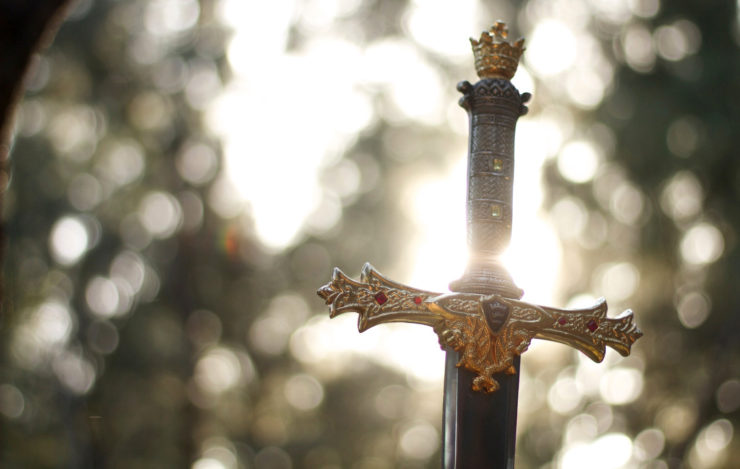We all love a good sword fight—the clashing of metal, the sparks that fly between well-matched opponents, the tension as two skilled warriors battle for superiority. Whether on film or on the page, we love a good duel. But fight scenes can be some of the hardest scenes to write, and writers can struggle with complicated choreography. Fortunately, some of our favorite writers have taken up the blade themselves. Author S.L. Huang spoke with V.E. Schwab, Yoon Ha Lee, Suzanne Walker, and Setsu Uzumé to talk about all things swords.
What type of sword did you train in? Which is your favorite to use?
S.L. Huang: I have to confess: I betray my fantasy nerd brethren by not having an exquisite, wedded-to-my-personality sword with a Significant Name and its own character. I think I own over a dozen swords right now and I’ve probably given away half again as many, but most of them fall a lot harder on the functional end! I really must find myself that one magical sword that is nearly alive and functions as my familiar. Y’all know what I mean.
In the meantime, I can answer this question about style of sword. Though my immediate instinct is: Oh, my, how does one choose?! I’ve lost count of how many different kinds of swords I’ve trained with at this point, and I love them all! But here’s an oft-overlooked style that I have a particular fondness for, partially because of its obscurity: classical French smallsword.
Here are two of my smallswords. After I bought them, I brought them to my swordsmith friend (because of course I have a swordsmith friend) and asked him to blunt them for me so I could use them to fight without… you know, actually killing someone. He brought them back to me and said, “I replaced them with epee blades instead! It’s better for what we do.” Ha!
So you can see them with epee blades below, and the original blades he took out of them:
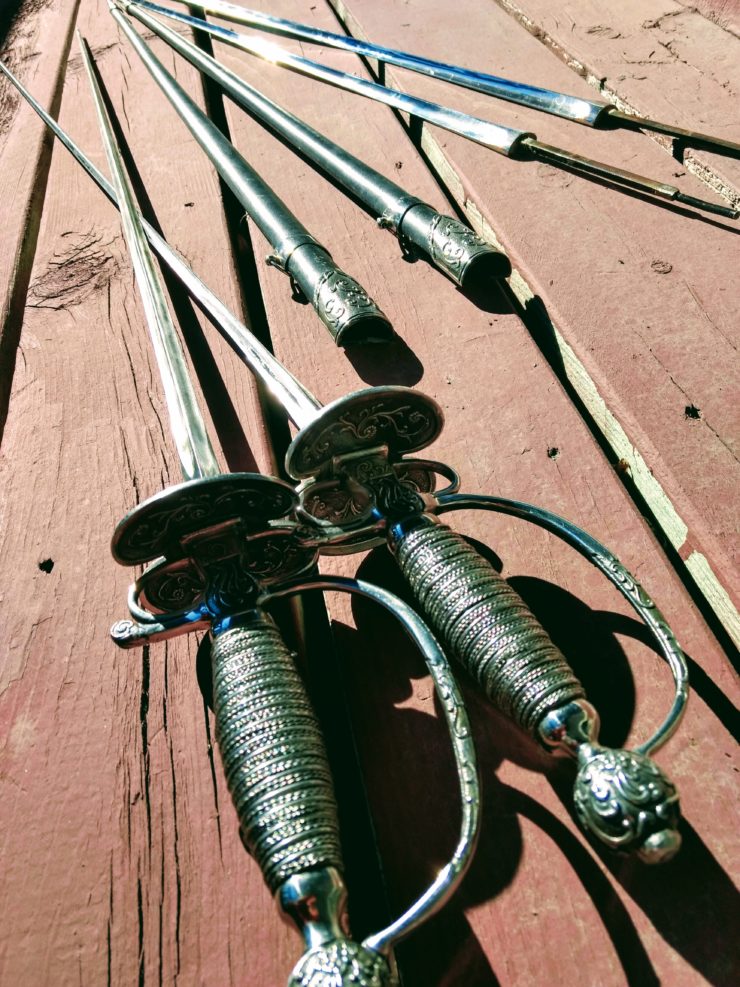
Smallsword is… an “advanced” weapon is probably the wrong way to put it, as all swords require training to get skilled. But there’s a lot of precision to smallsword that makes it more fiddly to learn, which I find quite fun. It’s a relatively late style, much closer to when sword fighting started to tip over into sport fencing—so it’s a bit nearer to fencing in aesthetic, though still quite different and with a whole library of historical balletic movements. Smallswords are very light thrusting weapons, with a lot of wrist work, and you can get away with some brilliant and hilarious fanciness.
But there’s one more reason I like smallsword particularly, and that’s that I’m CONTRARY. Because as a sword performer… I’ve been hired to do countless sword fights. And have I ever, ever been asked to do a classical French smallsword fight? No, of course not! You mainly only see them in historical dramas! Historical dramas in which the duelists are always always always WHITE MEN. So not only is it a rare style for a performer, but it’s an impossible style for a small Asian woman ever to get asked to do. They like handing me a katana instead. So yes. I am VERY contrary in my love of the rare, unasked-for, unwatched, undiverse weapon style that is classical French smallsword! (Seriously, though, it’s super fun.)
Suzanne Walker: Two-handed longsword. I train with the Chicago Swordplay Guild, which teaches historical European swordplay; I take classes in the armizare track, or “art of arms,” in the tradition of 14th-century Italian master Fiore dei Liberi.
V.E. Schwab: I was a competitive epee fencer! As in, the sword where you can hit your opponent anywhere you can reach (unlike foil) so long as you use the sword’s point (unlike sabre).
Yoon Ha Lee: I’m currently an epeeist, although I started with foil. This is the heaviest of the three sport (electric) fencing swords. Epee fencing is a little different because there’s no right of way (a set of rules that says whose attacks “count”), so if you hit you hit; you can have simultaneous hits (double touches); and the entire body is target, as opposed to just part of it for foil and sabre.
My trusty epee is named Only Slightly Bent, which is (a) accurate and (b) named after one of the mentioned ships in Iain Banks’ Culture series.

Setsu Uzumé: Chokuto. It’s like a katana, but the blade has no curve. As it happens, mine is also only slightly bent because it was a rescue—some dickhead was abusing trees with it. I’ve had it since I was about 12. It’s not terribly long, I can swing it freely without the tip touching the ground. Other than the engraving (strength, courage, contribution) it is not pretty. It is, however, solid, and I had to get special permission to compete with it.
What was your first introduction to fencing/swordwork? And how long have you been doing it?
SLH: My very earliest introduction was a local theatre stage combat course I took when I was about… oh, thirteen or fourteen. They taught us a few sad little basics with wooden dowels.
Buy the Book
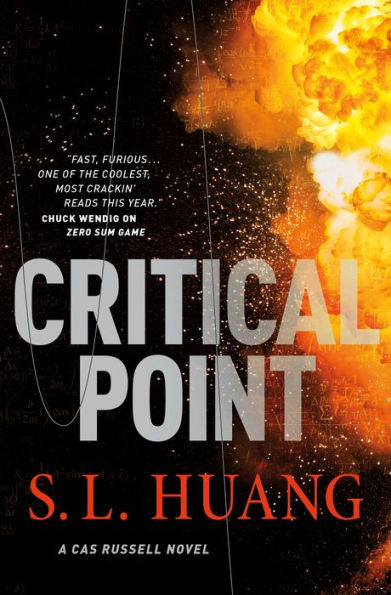

Critical Point
I wanted more DESPERATELY. But performance swordplay is not the most popular hobby, and there was no place around for me to find more training, alas. I took every one-off workshop I could find, but you can’t really learn much that way.
It was only later, when I was living in Boston and finally had easy access to a city, that I found a studio offering regular sword classes. I haunted the place and took every class they offered. Since then, every city I’ve moved I’ve found somewhere to continue. With some breaks for illness or injury recovery and whatever time it’s taken me after a move to find a new sword community, I guess the time I’ve been doing it regularly is climbing toward two decades now.
SW: My very first introduction was in the sixth grade, when I took a foil fencing class at the local community center. I loved it, but stopped after a few months because it took too much time away from figure skating, which was my main love as a kid. As an adult, I walked past the Chicago Swordplay Guild’s booth at C2E2 and realized I could practice historical swordplay at a gym in my own neighborhood, which was pretty cool! I have been training off and on since 2016 (more consistently “on” since 2018).
VS: Believe it or not, I fell in love with The Princess Bride when I was 12. Specifically Inigo Montoya’s dueling prowess. I told my mother, who jokingly said if I could find someone to teach me, I could take fencing lessons. She should have known better.
YHL: I first took Classical Fencing as a college freshman back in…sheesh, the fall of 1997, under Maître Adam Adrian Crown. I thought it would be closer to a “historical” fencing experience than the other option, which was electric fencing. I really enjoyed it. I was also, I suspect, the worst student in the class, with approximately the upper body strength of a cooked noodle.
I didn’t continue fencing at that time, and for years all I remembered was parry septime, of all things. In late February 2018, I convinced my husband to give it a try with me, so we went through the beginners’ class at the Red Stick School of Fencing in Baton Rouge, taught by Coach Ryan O’Connor. We fell in love with it and got our teenage daughter fencing too, and have been doing it ever since! This now includes my husband and I doing cockamamie fencing in the garage to keep in practice—we have all the gear so it’s safe if cramped.
SU: I’m the youngest of three, and we were all made to pick between ballet and TKD when we turned 6. I gave ballet an honest shot for three months, didn’t take to it, and spent the rest of my days doing the martial arts thing. My second school was Americanized and eclectic, and the instructor would do exchange programs and seminars with other schools in the area. I had done bunch of kobudo and other weapons training, but in order to prep for the black belt test (which we couldn’t take until we were 18), I had to specialize, so iaido for me. In my mid-20s I took lessons in Italian fencing and saber, but the learning curve was steep because the footwork is so different. I also studied jian at Wudang but that was only briefly. So maybe a solid ten years out of the last twenty? I love weapons in general, and keep getting distracted by other disciplines.
How is swordwork a part of your writing? Does it help you choreograph fight scenes?
SW: In most of my published writing, swordwork hasn’t factored in much at all (the witches of Mooncakes don’t have much use for blades), but in the novel I’m currently drafting (secondary-world fantasy based off medieval Islamic Empire), it factors in quite heavily. It absolutely has helped me choreograph fight scenes, and indeed, half of my justification for starting lessons was that it was “research.” Even if my characters fight using a martial tradition I’m not as familiar with, the basic knowledge of body mechanics and how to move/react in a fight (and how adrenaline really drives said fight and leads to some really messy moves). That said, it is frustrating in some ways, because I have a ton of knowledge about Italian/European medieval swordsmanship, but next to none about Middle Eastern medieval swordsmanship, which is what most of my characters’ styles would be based on. But that is what research is for! There are resources on historical martial arts traditions from all over the world.
Buy the Book
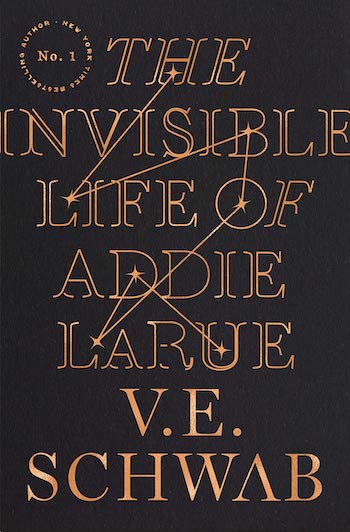

The Invisible Life of Addie LaRue
VS: Fencing is a precision sport. It takes practice to hone your form and accuracy, much like any creative craft. And sure, it gives you a good understanding of the human body, and the way it moves, but the combat is so structured by rules, I don’t find it the best for choreographing fight scenes. For those, I look to more practical swordplay.
YHL: I’m usually ass at fight scenes, but having muscle memory to draw upon helps me tremendously! I only regret that I didn’t start earlier. Concepts such as measure and timing become viscerally real in fencing, and one thing I learned is that it doesn’t matter how much you drill, the only way to find out how you fence in a bout is to fence a bout; I write somewhat combative space opera and this is really the closest I will ever get to the experience of a fight. (In my case, I discovered that my instinct is to be hyper-aggressive, which is a disadvantage in epee, and which I never would have guessed about myself!) I actually used a number of exchanges, either that I’d experienced or witnessed, as the basis of some of the swordfighting in the story I wrote for the forthcoming Silk and Steel anthology.
SU: Mostly it helps with characterization. It used to help with choreography, but we’ll get into that later. My opinion is that the “art” part of martial arts is self-development, and when you train with other people three hours a day, six days a week, for years—the ways in which one develops oneself conforms and diverges in narratively significant ways.
When I was 15 I had 5 peers of the same rank at my dojo. We had eaten through the curriculum, and the adult students were less experienced, so we didn’t have anyone to look up to but each other. We helped teach, competed, did demo team, but as I mentioned, we couldn’t advance until we turned 18. Somewhere between teaching and practice, we started to notice the little differences between us. Who was the most aggressive, or the most fluid, or had the best balance. Who hit their chambers differently and why, what about someone’s personality makes them choose kama rather than sword. We knew how to perform identically to each other, but our personalities came through during solo critique. There’s so much you can do with character through tics and habits, or the way they move.
SLH: Funny story. When I first started studying sword fighting seriously, I was working on a fantasy that (of course) had very many swords in it. I sat down to work on it, SUPER EXCITED, because now—now!—I Knew Things! I would be able to write the best sword fights ever. Pages of sword fighting poured out of me. I felt quite chuffed with myself. A few days later, I went back to the manuscript, and…It turns out that paragraphs and paragraphs of blow-by-blow feints and parries and ripostes is very very boring. I scrapped almost all of it, and learned a very important lesson that day.
But as I progressed in my sword studies—and as I became more seriously trained in performance fighting more generally—what has helped the most is that, when playing a character, we don’t stress the blow-by-blow of a fight most highly. Even though we’re fully choreographing every beat. Sure, cool fights are cool, but what matters most in theatrical or film fights—what keeps someone watching, or, in the case of a book, reading—are the emotional stakes. The character stakes. The feelings these characters are going in with, the small moments when the tenor of the fight changes… the performance of it, and the storytelling the action is doing. And all of that absolutely translates to writing. Of course, having worked with swords for so long does give me quite a large repertoire of texture I can draw on for any sword scenes. But I almost never strive to describe every move—and I put a lot of weight on immersing the reader in what’s happening between and behind and among those moves.
What piece of advice would you give other writers who incorporate blades in their work?
SU: So re: choreography above, when I first started writing the fights were more central and I loved writing them, but I internalized the advice about all readers skip them so it fell by the wayside. It’s tough. There’s a lot of conflicting advice—write accurately to avoid push-back, but not too accurately because it’s a story not a manual. But some readers want that and are looking for that. Some readers want to read D&D-style tit-for-tat, or high-intensity anime-style encounters where physics doesn’t matter—or poetic allusions with no mention of specific counterstrikes. What’ll work best is some combination of what you love and what fits the tone/style of your work. Read read read read read. Outside your genre, too.
Buy the Book
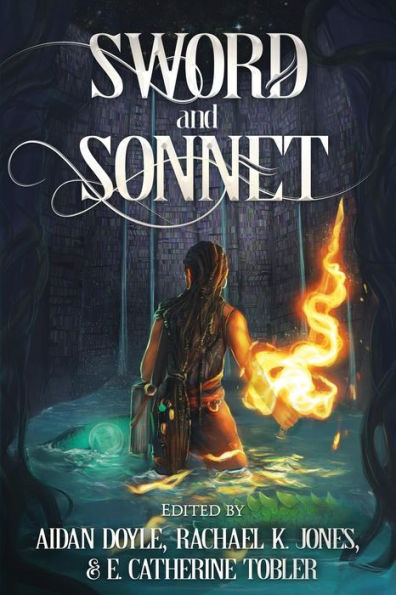

Sword and Sonnet
If you’re interested in training for the sake of your work, it depends what you want to learn. Technical stuff like the names and maintenance of equipment can help. How people deal with blood and danger might be a better question for a first responder than a martial arts teacher. Try to choose a place where you feel welcome, and the level of competition is fun. A lot of teachers (I guess self-included, now) like to talk about how awesome they were back in the day rather than conveying anything useful, so grain of salt when you visit clubs or take trial classes. If you only want feedback on a particular scene or character, find someone who knows their stuff, tell them what you’re trying to convey, and they’ll help you adjust. Everything comes down to personality and body-type. Character, again.
SW: Do your research! And if you can, try and block out moves with a friend—even if you don’t have a background in swordwork, it will give you an idea of what the body reasonably can and can’t do. But also recognize what function your blades and fight scenes are serving in their work: is it for plot? Character development?
VS: Don’t pick up a weapon and expect to master it right away. It’s as much a meditative exercise, or a instrumental one, as a physical endeavor. It’s about focus, and presence, and accuracy.
SLH: SWORDS ARE DANGEROUS! I would say this is the #1 mistake I see authors make—not treating a blade as sharp and dangerous enough. In fact, I wrote a whole article for Tor.com on it! Have your characters treat their swords as if they’re deadly weapons. Very, very sharp deadly weapons.
YHL: Do some research if you’re able, but depending on the genre you’re writing, you may not have to sweat the details too much. If you’re writing in a genre where 10000000% realism isn’t a big deal (howdy, space opera!), then it may not matter. On the other hand, if you know your audience cares about careful detail, then it might be worth spending some extra time and consulting someone who knows what they’re doing, or giving swordwork a try yourself if you can.
What movies or books feature your favorite sword fighting scenes? Which do you think are the most accurate with regards to skill, technique, etc?
VS: Well, obviously The Princess Bride.
Buy the Book
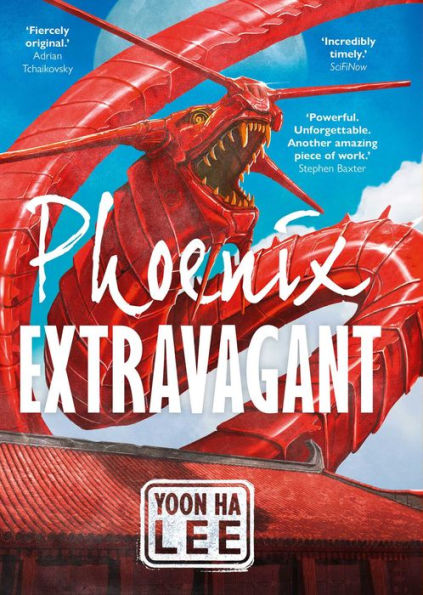

Phoenix Extravagant
YHL: I’m told The Princess Bride is the gold standard for movies but the last time I watched it was before I took up fencing! My favorite book for swordfighting is Roger Zelazny’s Nine Princes in Amber. I just reread a couple biographies of Zelazny (one by Theodore Krulik, the other by Jane Lindskold) and learned that he wasn’t just a martial artist in several disciplines, he was captain of the epee squad when he attended Western Reserve University. The Lindskold biography has a note by Zelazny that the Amber swordfights are correctly choreographed for rapier-class weapons, except for people with extra wrist strength because Amberites!
SW: I’m glad this question was divided into two, because I don’t think accuracy regarding skill/technique/etc are ever going to match with a favorite fight scene. The biggest reason being that my favorite scenes are the ones with drama, the ones that either tell a story or highlight character depth/development (see: Westly vs Inigo Montoya in The Princess Bride, Jack Sparrow vs Will Turner in the first Pirates of the Caribbean, pretty much anything Aragorn does in Lord of the Rings). Real swordfights are remarkably short; it does not take much time at all before someone scores a hit. In that respect (and regarding some techniques), the first episode of The Witcher was pretty darn accurate. I’ve loved revisiting Tamora Pierce’s Protector of the Small quartet: it was my favorite as a teen, and after rereading it with the knowledge I have now, it is still pretty on the nose!
As for accuracy, I asked Coach Ryan about that once and interestingly, he told me that he generally doesn’t sweat that stuff, especially in a book where the point is to read an exciting adventure. Coach Ryan is a historical fencer as well and he says that one thing that’s interesting when you go back to read all the manuals—Fabris, Capo Ferro, you name it—they all have radically different approaches to the same problem. I remember the one time I participated in an epee melee, there was an incredible range of different styles on display, even among the rated fencers. You do occasionally see silly things like the complete lack of guards on Star Wars lightsabers, but hey, maybe that’s how they cull unworthy Jedi!
SU: Michelle Yeoh vs. Zhang Ziyi from Crouching Tiger, Hidden Dragon. And they both have ballet backgrounds! Full-circle.
This happens less frequently with sword fights because you need to keep the performers safe, but my absolute favorite fights are the ones where you can’t tell who trained in what—and the ones where they accomplish the very difficult trick of making it look like they’re aiming at the person and not the weapon. Good form in competition is great; but I don’t think someone who lives and dies by their weapon restricts themself to good form. Which brings me to Joe Abercrombie’s work. He shows people getting up early and running for miles to train. Their armor gives them weird tan lines. Everyone’s insecurities and fears show through in how they move and the choices they make when they’re in the middle of the giant blender we call a land war. His characters fight dirty, and his fights are MESSY. People trip. They make mistakes. I love that. He captures the chaos of it all.
SLH: Any movie choreographed by Bob Anderson (may he rest in peace) is going to be amazing. Bob Anderson is one of the giants of choreographed swordplay. I will forever have a grudge against the Oscars for not featuring him in the In Memoriam the year that he died. Bob Anderson did some of our great geek favorites, too, like The Princess Bride, Star Wars, and The Lord of the Rings.
But one of the best fights in cinema is from a more obscure movie that my first swordmaster recommended to me: Rob Roy, with sword fights choreographed by William Hobbs. My swordmaster had us watch it with an eye to character, and every time I rewatch the final duel between Liam Neeson and Tim Roth, it floors me. The two characters have such obviously different styles, so deeply linked to their histories and personalities… and those characterizations are baked into every moment of that fight, as Liam Neeson battles with everything he has and Tim Roth shows off. The emotional and physical stakes simmer in every move, too—and the way it’s filmed showcases that, with a lot of wide shots and almost no music. Everything is about the fight, and it’s so fabulously done.
Who is your favorite fictional swordsperson?
VS: Inigo Montoya for life.
Buy the Book
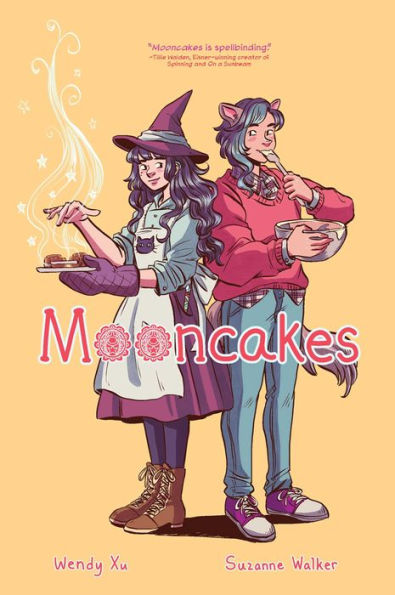

Mooncakes
SW: two-way tie between Keladry of Mindelan and Eowyn.
YHL: Corwin of Amber. He’s hot and he grows up to be a better person.
SU: Xena.
SLH: Oh, a very unfair question! There are way too many good ones! So I’m going to go with an offbeat choice who encapsulates all the joy I find in swordplay—Elaine Roberts from xkcd. (Full name: Help I’m trapped in a driver’s license factory Elaine Roberts.) Elaine is the star of xkcd’s 1337 series, and after wacky hijinks in which she trains with Donald Knuth Kill Bill-style in his mountain hideaway and invents the iPhone, she ends up dueling two black hat agents from the RIAA and the MPAA. In this comic from the middle of the series, she asks Lawrence Lessig, “So, how do we fix the system? Stab bad guys?” Yes, Elaine. You are a person after my own heart. Stab all the bad guys. I don’t think I can choose between her and the other two Dread Pirate Robertses we know, but I think Elaine would give Inigo and Westley a run for their money.
Now, my runner-up choice for this question? Sir Percy Blakeney from The Scarlet Pimpernel—the musical, not the book, and as played by Douglas Sills and as choreographed by Rick Sordelet. Hey, I’m a sword nerd, these details are important.
If you could duel one notable figure (author, celebrity, historical figure, etc), who would you duel?
SU: Hard to say. If I had to pick someone to learn from, I’d want someone who was banned from competing because they were the wrong gender or from the wrong family. Someone who kept on going when the law erased their name.
SW: Thomas Jefferson, because that jackass deserved a good stabbing.
VS: Julie D’Aubigny! Hands down. I mean, 17th century cross-dressing lesbian sword-fighter who loved duels and sweeping women off their feet.
SLH: Galois! I would throw the duel and let him kill me, so he could live on and rewrite the history of mathematics! I jest, of course… because Galois was killed in a pistol duel, not with swords.
This probably requires some explanation. Évariste Galois was a French mathematician in the nineteenth century who invented large chunks of what is now modern algebra by the time he was twenty. How do we know he did it all at such a young age? Because at age twenty, he was killed. In a duel. Over a woman. It’s not worth it, kids. Don’t fight in duels; do math instead.
YHL: Well, what I want to know first is, is this to the death???
I mentioned this question to my teenage daughter and her answer was that obviously she’d choose to duel a really easy opponent, like a child, so she’d win! Man, teenagers are ruthless. If it were possible, I’d love to fence Zelazny—his work has had an immeasurable influence upon my own. If I were picking someone living, I think it would be hilarious to fence Max Gladstone if he were willing, although I am very much a novice and also I’m out of practice with the foil! But I’m sure I’d learn a lot from the experience.










